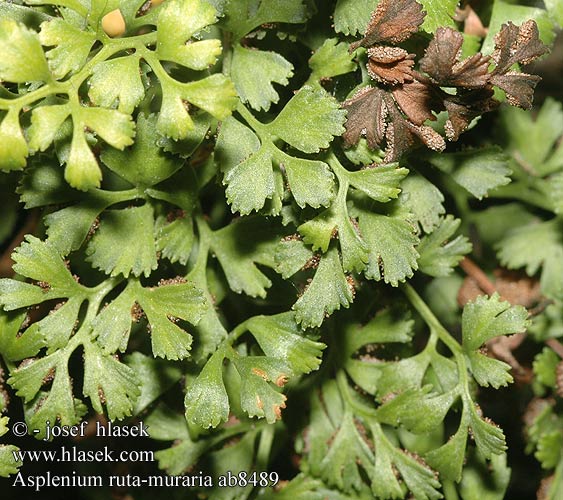Asplenium ruta-muraria
Wall-rue ( Asplenium ruta - muraria )
The wall-rue, or wall - Spleenwort ( Asplenium ruta - muraria ) is a plant from the family of Streifenfarngewächse, which often grows synanthropic in the cracks and mortar joints of old walls.
Features
There are small evergreen ferns with 3-10 (-15 ) cm long leaves. The leaves are pinnate two to three times and in outline irregular triangular to oval. The pinnae are diamond-shaped, narrowed thickness taper at the bottom and notched front and cut to about 2 to 3 mm long. The leaf stalks are like the upper side of blade green. Are the sori mature, so they cover the entire underside of the pinnules, this is then brown.
Dissemination
The wall-rue is common in all temperate regions of the northern hemisphere. Originally, they grew up in crevices in the mountains and uplands. She tolerates both calcareous rocks such as acidic. However, she prefers calcareous and nutrient-rich sites.
Because of this location preferences to find the wall-rue also very common in wall joints, up to the inner cities. While it occurs in its natural habitats only as a companion other crevices plants, it is outside the mountain range is characteristic for its own plant community ( Asplenietum trichomano - Rutae - murariae; wall-rue corridor).
In Austria, this kind collin to subalpine widespread and very common in all states.
However, in Schleswig- Holstein, the wall-rue occurs only very rarely, for example at Flensburg station. She stands there on the Red List.
Importance as a forage crop (selection)
The caterpillars of the following butterfly species are dependent on the plant as a food source.
- Hellgebänderter stone tensioner ( Gnophos pullata )
Trivial names
In Lower Austria, this type is referred to as " Stoanneidkraut " in the vernacular. It should help with his magic powers against the " Verneiden " ( Hex ) and was fed to the cattle. The German Dictionary of Jacob and Wilhelm Grimm According ie the wall-rue also " Eselsfarn ": " Eselsfarn, m. adianthum capillus Veneris, otherwise also krullfarn, from the shape of the leaves, wall diamond, diamond stone. Lonicerus 248b. "
In the German-speaking area or have been for this species, some only regionally, the other following trivial names used: Capelleken, Capelliche, Chappachläre ( Appenzell ), Chappilläre ( Appenzell ), Erdbrauen, Erdhar, Eselfarlin, white women's hair, Frauenlokkraut, Harngras (Tirol near Lienz ), Hard body, Juncvrowenhaar, virgin hair, wall diamonds, Meichelkraut, Murrutten, Steenruet, Steinrute, Stenvarn ( middle Low German ), Venus Hair, Wedertam ( Old High German ), Weinkräutl ( Pongau, Pinzgau ) Widderdan, Widertate ( middle High German ), Widertat ( middle High German ) and Widertot ( middle High German ).



_-_geograph.org.uk_-_1380293.jpg)





